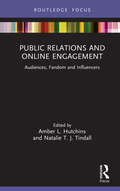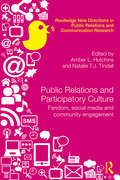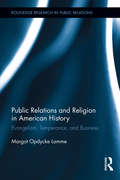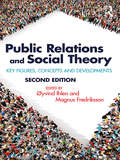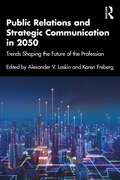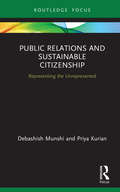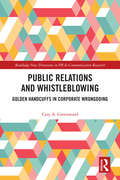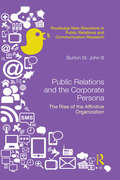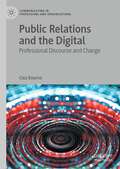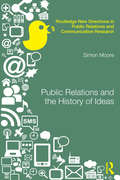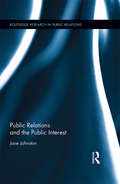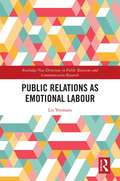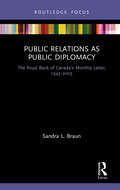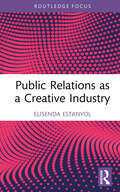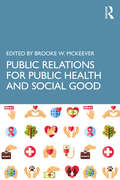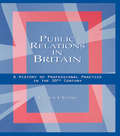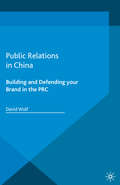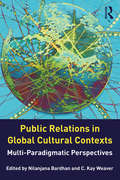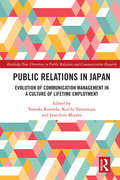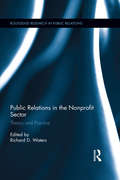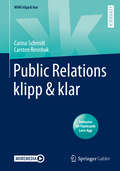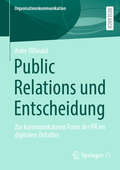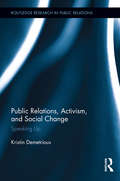- Table View
- List View
Public Relations and Online Engagement: Audiences, Fandom and Influencers (Routledge Insights in Public Relations Research)
by Amber L. Hutchins; Natalie T. J. TindallAs media continues to evolve, social media has become even more integral to public relations activities, presenting new opportunities and challenges for practitioners. Relationships between publics and organizations continue to be first and foremost, but the process and possibilities for mutually beneficial relationships are being rewritten in situ. This volume aims to explore and understand highly engaged publics in a variety of social media contexts and across networks. The hope is the expansion and extension of public relations theories and models in this book helps move the discipline forward to keep up with the practice and the media environment. Contributors analyzed a range of organizations and industries, including corporate, entertainment, government, and political movements, to consider how public relations practitioners can facilitate ethical and effective communication between parties. A consistent thread was the need for organizations and practitioners to better understand the diverse backgrounds of publics, including age, ethnicity, gender, and sexual orientation, beyond surface-level demographic stereotypes and assumptions. This book will be of interest to researchers, academics, and students in the field of public relations and communication, especially those with a particular interest in online engagement and social media as a PR tool.
Public Relations and Participatory Culture: Fandom, Social Media and Community Engagement (Routledge New Directions in PR & Communication Research)
by Amber Hutchins Natalie T.J. TindallWhile public relations practitioners have long focused on the relationship between organizations and their stakeholders, there has never been a time when that relationship was so dominated by public participation. The new model of multiple messages originating from multiple publics at varying levels of engagement is widely acknowledged, but not widely explored in scholarly texts. The established model of one-way communication and message control no longer exists. Social media and an increasingly participatory culture means that fans are taking a more active role in the production and co-creation of messages, communication, and meaning. These fans have significant power in the relationship dynamic between the message, the communicator, and the larger audience, yet they have not been defined using current theory and discourse. Our existing conceptions fail to identify these active and engaged publics, let alone understand virtual communities who are highly motivated to communicate with organizations and brands. This innovative and original research collection attempts to address this deficit by exploring these interactive, engaged publics, and open up the complexities of establishing and maintaining relationships in fan-created communities.
Public Relations and Religion in American History: Evangelism, Temperance, and Business (Routledge Research in Public Relations #5)
by Margot Opdycke LammeWinner of The American Journalism Historians Association Book of the Year Award, 2015 This study of American public relations history traces evangelicalism to corporate public relations via reform and the church-based temperance movement. It encompasses a leading evangelical of the Second Great Awakening, Rev. Charles Grandison Finney, and some of his predecessors; early reformers at Oberlin College, where Finney spent the second half of his life; leaders of the Woman’s Christian Temperance Union and the Anti-Saloon League of America; and twentieth-century public relations pioneer Ivy Ledbetter Lee, whose work reflecting religious and business evangelism has not yet been examined. Observations about American public relations history icon P. T. Barnum, whose life and work touched on many of the themes presented here, also are included as thematic bookends. As such, this study cuts a narrow channel through a wide swath of literature and a broad sweep of historical time, from the mid-eighteenth century to the first decades of the twentieth century, to examine the deeper and deliberate strategies for effecting change, for persuading a community of adherents or opponents, or even a single soul to embrace that which an advocate intentionally presented in a particular way for a specific outcome—prescriptions, as it turned out, not only for religious conversion but also for public relations initiatives.
Public Relations and Social Theory: Key Figures, Concepts and Developments (Routledge Communication Series)
by Øyvind Ihlen Magnus FredrikssonPublic Relations and Social Theory: Key Figures, Concepts and Developments broadens the theoretical scope of public relations studies by applying the work of a group of prominent social theorists to make sense of the practice. The volume focuses on the work of key social theorists, including Max Weber, Karl Marx, John Dewey, Jürgen Habermas, Niklas Luhmann, Michel Foucault, Ulrich Beck, Pierre Bourdieu, Anthony Giddens, Robert Putnam, Erving Goffman, Peter L. Berger, Gayatri Chakravorty Spivak, Bruno Latour, Dorothy Smith, Zygmunt Bauman, Harrison White, John W. Meyer, Luc Boltanski and Chantal Mouffe. Each chapter is devoted to an individual theorist, providing an overview of that theorist’s key concepts and contributions, and exploring how these can be applied to public relations as a practice. Each chapter also includes a box giving a short and concise presentation of the theorist, along with recommendation of key works and secondary literature.
Public Relations and Strategic Communication in 2050: Trends Shaping the Future of the Profession
by Alexander V. Laskin Karen FrebergTaking stock of the technological, political, economic, and social trends that exist today, this book extends the discussion to analyze and predict how these trends will affect the public relations and strategic communication industry of the future.This book is divided into two sections, the first addressing such key topics as artificial intelligence (AI), big data, political polarization, and misinformation, the second looking at key facets of the profession, such as media relations, crisis communication, and measurement and evaluation. Leading researchers in the discipline share their analysis of these topics while also providing theoretically based and practically relevant insights on how the industry must evolve to keep up with, and perhaps anticipate, changes in culture, society, and technology.This book will be of interest to scholars, industry professionals, and advanced undergraduate and graduate students in public relations and strategic communication.
Public Relations and Sustainable Citizenship: Representing the Unrepresented (Routledge Insights in Public Relations Research)
by Debashish Munshi Priya KurianThis book examines how public relations might re-imagine itself as an instrument of "sustainable citizenship" by exploring alternative models of representing and building relationships with and among marginalised publics that disrupt the standard discourses of public relations. It argues that public relations needs to situate itself in the larger context of citizenship, the values and ethics that inform it and the attitudes and behaviours that characterize it. Interlacing critical public relations with a theoretical fabric woven with strands of postcolonial histories, indigenous studies, feminist studies, and political theory, the book brings out the often-unseen processes of relationship building that nurtures solidarity among historically marginalized publics. The book is illustrated with global cases of public relations as sustainable citizenship in action across three core elements of the earth – air, water, and land. In each of the cases, readers can see how resistance movements, not necessarily aligned with any specific organization or interest group, are seeking to change the status quo of a world increasingly defined by exploitation, overconsumption, sectarianism, and faux nationalism. This challenging book will be of interest to students and scholars of not only public relations but also the broader social and management sciences who are interested in issues of environmental and social justice.
Public Relations and Whistleblowing: Golden Handcuffs in Corporate Wrongdoing (Routledge New Directions in PR & Communication Research)
by Cary A. GreenwoodThere is a growing interest in corporate whistleblowing, but no comprehensive research has yet focused on public relations practice. Drawing on extensive research on Fortune 1000 and Wilshire 5000 corporations, this book reveals executives’ attitudes and relationships toward their organizations and their impact on whistleblowing. Perhaps unsurprisingly, it reveals that wrongdoing in corporations and the privileges of power coexist. Top-ranking public relations executives, who are mostly white and male, are more likely to be aware of wrongdoing but no more likely to blow the whistle, fundamentally due to their positive relationship with their employers. Using the new lens of evolutionary theory, this study explains whistleblowing, retaliation, and relationships, and in the light of the connection between whistleblowing behavior and executives’ attitudes, it proposes a new theory of the phenomenon of Golden Handcuffs. As public attitudes to corporations, corporate social responsibility (CSR), and transparency harden, these findings have serious implications for companies globally. Researchers, scholars, and advanced students in public relations, organizational communication, corporate communication, strategic communication, corporate reputation, and CSR will find this book full of revealing insights.
Public Relations and the Corporate Persona: The Rise of the Affinitive Organization (Routledge New Directions in PR & Communication Research)
by Burton Saint John IIIFor much of the last century, large, predominantly US corporations used public relations to demonstrate that their missions resonated with dominant societal values. Through the construction and conveyance of the "corporate persona", they aimed to convince citizens that they share common aspirations - and moreover that their corporate "soul" works as a beneficent force in society. Through examining key examples from the last 80 years, this book argues that PR, through the corporate persona, works to create a sense of shared reality between the corporation and the average citizen. This has been instrumental in conveying, across generations, that the corporation is an affinitive corporate persona - a fellow companion in the journey of life. The construct is obviously ripe for manipulation, and the role of PR in creating and promoting the corporate persona in order to align corporations and stakeholders is potentially problematic. From wage inequality to climate change, preserving the corporate status quo may be negative. This original and thought-provoking book not only critically analyses how PR and its role in the corporate persona works to solidify power, but also how that power might be used to further goals shared by the corporation and the individual. Scholars and advanced students of public relations, organizational communications and communication studies will find this book a challenging and illuminating read.
Public Relations and the Digital: Professional Discourse and Change (Communicating in Professions and Organizations)
by Clea BourneThis book takes a people-centred approach to the ever-fluid and rapidly-transforming professional world of public relations (PR) in the age of digital platforms. As everyday PR work becomes increasingly shaped by the platform economy, this is transforming how the PR profession talks about itself, its issues and concerns. Drawing on different textual genres and discursive strategies, the author examines the shifting boundaries between PR and adjacent fields such as advertising, marketing and journalism – and illuminates varied lifeworlds of PR professionals from different backgrounds, races and genders. Written for academics, practitioners and those interested in the world of public relations, the book will also be enjoyed by young professionals working in this interesting and fast-changing occupation.
Public Relations and the History of Ideas (Routledge New Directions in Public Relations & Communication Research)
by Simon MooreThis innovative book explores ten great works, by well-known thinkers and orators, whose impact has been intellectual, practical and global. Most of the works significantly precede public relations as a phrase or profession, but all are in no doubt about the force of planned public communication, and the power that lies with those managing the process. The works are stimulating and diverse and were written to address some of society’s biggest challenges. Although not traditionally the focus of public relations research, they have all had a global impact as communicators and as the foundation for fundamental ideas, from spirituality to war and economics to social justice. Each addresses the implications of structured communication between organizations and societies, and scrutinizes or advocates activities that are now central to PR and its morality. They could not ignore PR, and PR cannot ignore them. This book will be essential reading for researchers and scholars in public relations and communication and will also be of inter-disciplinary interest to study in sociology, literature, philosophy, politics and history.
Public Relations and the Public Interest (Routledge Research in Public Relations)
by Jane JohnstonIn this book, Johnston seeks to put the public interest onto the public relations ‘radar’, arguing the need for its clear articulation into mainstream public relations discourse. This book examines literature from a range of fields and disciplines to develop a clearer understanding of the concept, and then considers this within the theory and practice of public relations. The book’s themes include the role of language and discourse in establishing successful public interest PR and in perpetuating power imbalances; intersections between CSR, governance, law and the public interest; and how activism and social media have invigorated community control of the public interest. Chapters explore the role of the public interest, including cross-cultural and multicultural challenges, community and internal consultation, communication choices and listening to minorities and subaltern publics.
Public Relations and the Rise of AI
by Regina Luttrell Adrienne A. WallaceThis book explores the potential of artificial intelligence (AI) to transform public relations (PR) and offers guidance on maintaining authenticity in this new era of communication.One of the main challenges PR educators, researchers, and practitioners face in the AI era is the potential for miscommunication or unintended consequences of using AI tools. This volume provides insights on how to mitigate these risks and ensure that PR strategies are aligned, offering practical guidance on maintaining trust and authenticity in PR practices. Readers will learn to leverage AI for enhanced communication strategies and real-time audience engagement while navigating the ethical and legal implications of AI in PR. Featuring contributions from leading scholars, the book includes case studies and examples of AI-driven PR practices, showcasing innovative approaches and lessons from well-known brands. It offers a global perspective on AI’s impact on PR, with insights for practitioners and scholars worldwide.This book equips public relations educators, researchers, and professionals with the knowledge and tools they need in the changing landscape of communication in the age of AI.
Public Relations as Emotional Labour: TBC (Routledge New Directions in PR & Communication Research)
by Liz YeomansInextricably linked to neoliberal market economies, public relations’ influence in our promotional culture is profound. Yet many aspects of the professional role are under-researched and poorly understood, including the impact on workers who construct displays of feeling to elicit a desired emotional response, to earn trust and manage clients. The emotionally demanding nature of this aspirational work, and how this is symptomatic of "always on" culture, is particularly overlooked. Drawing on interviews with practitioners and agency directors, together with the author’s personal insights from observations in the field, this book fills a significant gap in knowledge by presenting a critical-interpretive exploration of everyday relational work of account handlers in PR agencies. In underscoring the relationship-driven, highly contingent nature of this work, the author shows that emotional labour is a defining feature of professionalism, even as public relations is reconfigured in the digital age. In doing so, the book draws on a wide range of related contemporary social and cultural theories, as well as critical public relations and feminist public relations literature. Scholars, educators and research students in PR and communications studies will gain rich insights into the emotion management strategies employed by public relations workers in handling professional relationships with clients, journalists and their colleagues, thereby uncovering some of the taken-for-granted aspects of this gendered, promotional work.
Public Relations as Public Diplomacy: The Royal Bank of Canada’s Monthly Letter, 1943-2003 (Global PR Insights)
by Sandra L. BraunThis is a study of the Royal Bank of Canada’s Monthly Letter, which was initially created in 1920 as a traditional economic newsletter and later evolved quite serendipitously into a publication marvel when, in 1943, it came under the influence of John Heron, journalist and publicist, gaining mass appeal both domestically and abroad. This concise history documents the inception, development and rise to popularity of the Monthly Letter, telling the untold story of how a corporate newsletter became a tool of international public diplomacy. The purpose of this writing is to demonstrate the entanglement of the fields of public diplomacy and public relations and to offer a more palatable conceptualization of them as two discrete, but necessary, parts of a whole. It acknowledges the varied soup of contested terminology which surrounds the field of public diplomacy (e.g. corporate diplomacy, cultural diplomacy and economic diplomacy). This work conceptualizes public diplomacy and public relations as two parts of a whole in which the sum is greater than its individual parts, juxtaposing the two fields in relation to one another, diminishing neither. The contents of this work provide a broad overview of the fields of public diplomacy and public relations that could serve as an introduction and discussion point for students and scholars in both fields and offers a specific case study around which lively discussion and additional study can ensue.
Public Relations as a Creative Industry (Routledge Research in the Creative and Cultural Industries)
by Elisenda EstanyolThis shortform book defines and situates the role of Public Relations as a creative industry and discusses the trends and issues that the sector is facing within the wider context of the Creative Industries. Traversing and distilling both industry and scholarly research, the author will call on perspectives from a range of areas, including creativity, psychology, advertising, and marketing. Creativity and innovation are crucial elements in times of profound transformation such as those being experienced nowadays by the PR industry. The ability to generate new ideas is a competitive advantage of organizations. Nevertheless, although traditionally the focus has been on individual creativity, this book highlights the importance of organizational creativity in PR, becoming a result of teamwork and social interaction. This book will be a valuable resource for researchers and scholars looking at how creativity is an important asset in Public Relations. It will also be useful for students of Corporate Communication and Public Relations studies, for both undergraduate and postgraduate programs and PR practitioners who want to increase their creativity, learning from creative techniques and case studies.
Public Relations for Public Health and Social Good
by Brooke W. McKeeverForegrounding the work professional communicators do to support public health and social missions, this book examines how the principles and practices of public relations can be applied by nonprofit, government, and corporate entities working to understand and improve public health and social conditions.Many organizations attempt to influence prosocial behaviors, such as donating one’s time, money, or talents; participating in advocacy or activism; or otherwise working to protect public health or inspire social change. This book explores research and practice related to communication and other factors involved in motivating such efforts. Each chapter focuses on a different topic, providing definitions, summarizing research, and explaining how it has been or can be applied to practice, and ends with discussion questions to consider and references for further reading.Ideally placed for advanced undergraduate and graduate courses in public relations, health communication, or strategic communication as well as for communications professionals looking to apply research to their practice.
Public Relations in Britain: A History of Professional Practice in the Twentieth Century
by Jacquie L'EtangIn this book the author asks a big question: how did public relations develop in Britain and why? The question is answered through a broad ranging narrative which links the evolution of British public relations in the early twentieth century to key political, economic, social, and technological developments. Drawing on oral history interviews and extensive archival research the book highlights some of the sociological issues relevant to a study of public relations and foregrounds the professionalisation of the occupation in the second part of the twentieth century.
Public Relations in China: Building and Defending your Brand in the PRC (Palgrave Pocket Consultants)
by D. WolfIn this pithy yet compact book, David Wolf, provides business owners and PR practitioners with a roadmap to corporate credibility in China. Laced with thoughtful advice and braced with illustrative cases, Public Relations in China strips out the jargon and offers something rare: a practical handbook for building and defending a brand in China.
Public Relations in Global Cultural Contexts: Multi-paradigmatic Perspectives (Routledge Communication Series)
by Nilanjana Bardhan C. Kay WeaverWhile public relations practice has become increasingly globalized, scholars are still behind in theorizing about the intersections of culture, communication, and power at this level of practice. This volume emphasizes theories and concepts that highlight global interconnectedness through a range of interpretative and critical approaches to understanding the global significance and impacts of public relations. Providing a critical examination of public relations’ contribution to globalization and international power relations, the chapters included here explore alternative paradigms, most notably interpretive and critical perspectives informed by qualitative research. The volume encourages alternative ‘ways of knowing’ that overcome the shortcomings of positivist epistemologies. The editors include multiple paradigmatic approaches for a more complex understanding of the subject matter, making a valuable contribution toward widening the philosophical scope of public relations scholarship. This book will serve well as a core text in classes in international public relations, global public relations, and advanced strategic public relations. Students as well as practitioners of public relations will benefit from reading the perspectives included here.
Public Relations in Japan: Evolution in a Culture of Lifetime Employment (Routledge New Directions in PR & Communication Research)
by Junichiro Miyabe Yamamura Koichi Tomoki KuniedaDespite its rapid economic development, Japan lacks a large public relations industry and its role is viewed very differently from its Western counterparts. PR functions are handled predominantly in-house and a degree in a PR field is not a hiring requirement for those agencies which do operate. Mainstream PR history focusses entirely on its organizational aspects, and there are no Japanese PR "gurus" defining the field.
Public Relations in the Gulf Cooperation Council Countries: An Arab Perspective (Routledge New Directions in PR & Communication Research)
by Dean Kruckeberg Talal M AlmutairiThe Arab world has engaged in public relations for thousands of years, and the public relations literature provides multiple examples extending from ancient times. However, modern public relations is much more vaguely defined. This is partly because the research surrounding public relations practice in the Middle East remains sparse, especially in the Gulf Cooperation Council (GCC) countries. <P><P>This book presents a clear picture of contemporary PR practice in this region, providing a background on the evolution of public relations in each GCC country. It shows how environmental factors (historical, cultural, socio-political, and economic) influence practice in the region. It also contributes to public relations scholarship, education, and practice worldwide by providing new perspectives to those unfamiliar with its practice in this region. <P><P>This book will benefit scholars and practitioners alike through its informed analysis of the strengths and weaknesses of practice in the GCC countries, as well as being of great benefit to the development of professional practice in the region.
Public Relations in the Nonprofit Sector: Theory and Practice (Routledge Research in Public Relations)
by Richard D. WatersNonprofit organizations are managing to carry out sophisticated public relations programming that cultivates relationships with their key audiences. Their public relations challenges, however, have routinely been understudied. Budgetary and staffing restraints often limit how these organizations carry out their fundraising, public awareness and activism efforts, and client outreach. This volume explores a range of public relations theories and topics important to the management of nonprofit organizations, including crisis management, communicating to strengthen engagement online and offline, and recruiting and retaining volunteer and donor support.
Public Relations klipp & klar (WiWi klipp & klar)
by Carsten Rennhak Carina SchmidtDieses kompakte Lehrbuch bietet Studierenden und Berufseinsteigern einen übersichtlichen und schnellen Zugang zu den relevanten Aspekten der Public Relations. Dies ermöglicht ihnen einen souveränen Umgang mit PR-Fragestellungen in Theorie und Praxis. Wer PR-Maßnahmen optimieren möchte, muss verstehen wie PR-Werkzeuge funktionieren und welche Wirkungen sich mit ihnen erzielen lassen. Die Autoren detaillieren deshalb Ziele und Instrumente der PR. Aufgrund der deutlich gestiegenen Anforderungen in diesem Bereich nimmt das Buch besonderen Bezug auf ethische Richtlinien in der PR, die sich sowohl in Form von Gesetzen als auch Kodizes manifestiert haben. Abschließend werden verschiedene Berufsfelder im PR-Bereich vorgestellt. Über den Inhalt hinaus verschafft das Buch Leserinnen und Lesern einen Zugang zu einem breiten Fundus an Literatur und befähigt sie, sich selbst Wissen anzueignen und die erlernten Grundlagen zu vertiefen. Didaktische Mittel wie Lernziele, Zusammenfassungen und Definition vereinfachen dabei das Lernen.Zusätzliche Fragen per App: Laden Sie die Springer Nature Flashcards-App kostenlos herunter und nutzen Sie exklusives Zusatzmaterial, um Ihr Wissen zu prüfen.
Public Relations und Entscheidung: Zur kommunikativen Form der PR im digitalen Zeitalter (Organisationskommunikation)
by Anke OßwaldAnke Oßwald entwickelt in dem vorliegenden Buch eine entscheidungsorientierte Perspektive auf Public Relations. Aufbauend auf einem systemtheoretischen Kommunikationsverständnis konzipiert sie PR als spezifische Entscheidungspraxis und zeigt, welche weitergehenden Erkenntnismöglichkeiten damit verbunden sind. So lassen sich unter anderem Automatisierungsprozesse deutlich differenzierter darstellen und die Folgen für Öffentlichkeit diskutieren. Neue Impulse ergeben sich auch für die Schnittstelle von PR- und Organisationsstudien sowie für die kommunikationswissenschaftlich ausgerichtete Strategieforschung.
Public Relations, Activism, and Social Change: Speaking Up (Routledge Research in Public Relations)
by Kristin DemetriousWinner of the 2014 NCA PRIDE Book Award Why are some voices louder in public debates than others? And why can’t all voices be equally heard? This book draws significant new meaning to the inter-relationships of public relations and social change through a number of activist case studies, and rebuilds knowledge around alternative communicative practices that are ethical, sustainable, and effective. Demetrious offers a powerful critical description of the dominant model of public relations used in the twentieth century, showing that ‘PR’ was arrogant, unethical and politically offensive in ways that have severely weakened democratic process and its public standing and professional credibility. The book argues that change within the field of public relations is imminent and urgent—for us all. As the effects of climate change intensify, and are magnified by high carbon dioxide emitting industries, vigorous public debate is vital in the exploration of new ideas and action and if alternative futures are to be imagined. In these conditions, articulate and persistent publics will appear in the form of grassroots activists, asking contentious questions about risks and tabling them for public discussion in bold, inventive, and effective ways. Yet the entrenched power relations in and through public relations in contemporary industrialized society provide no certainty these voices will be heard. Following this path, Demetrious theorises an alternative set of social relations to those used in the twentieth century: public communication. Constructed from communicative practices of grassroots activists and synthesis of diverse theoretical positions, public communication is a principled approach that avoids the deep contradictions and flawed coherences of essentialist public relations and instead represents an important ethical reorientation in the communicative fields. Lastly, she brings original new perspectives to understand current and emergent developments in activism and public relations brought about through the proliferation of Internet and digital cultures.
